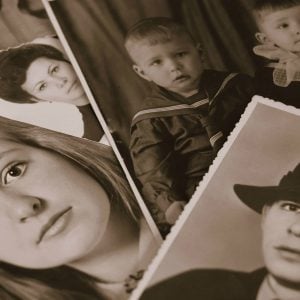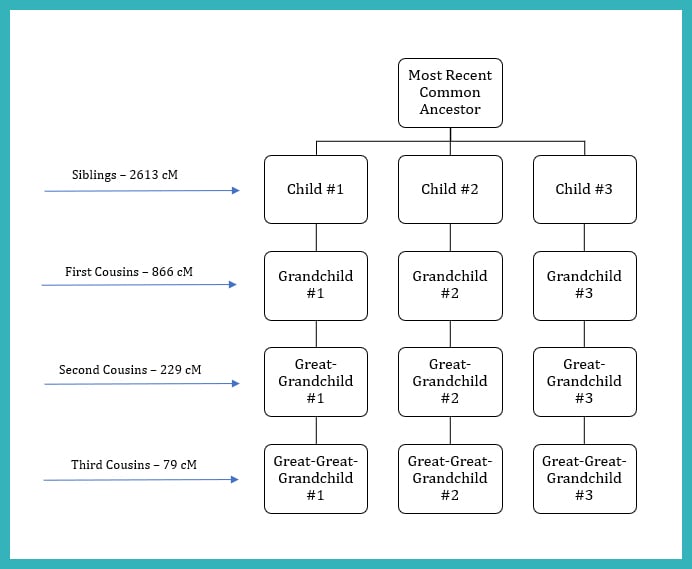What Does It Mean When a Dna Match Shows Up as a Close Reationship Instead of Immediate Family
Genealogy can be fun and rewarding, but it can as well exist frustrating when you see bug that don't seem to brand sense. What do you exercise if your family member's DNA doesn't seem to match your own? Legacy Tree Genealogists' Adrienne Abiodun explains how y'all can solve this all-too-common trouble.
The Problem

Why would relatives non be a Deoxyribonucleic acid match?
Well-nigh of us who have taken a Deoxyribonucleic acid exam have experienced the startling discovery of Not having a biological relative, close or distant, known to be related to show upward as a genetic lucifer. While jumping to conclusions and thinking the absolute worst is a natural reaction, taking a step back to appraise the data or lack thereof may salve y'all unnecessary confusion and heartache in the end. Siblings, half-siblings, aunts, uncles, nieces, nephews, first cousins, 2nd cousins, and other immediate relatives should always share enough DNA to announced in genetic match lists beyond all major DNA testing sites. However, third cousins, kickoff cousins, and second cousins that are ii or 3 times removed may not e'er show up as a match.
For simplicity'south sake, permit'due south consider an example of 3rd cousins. On boilerplate third cousins will share approximately 0.98 per centum of their DNA, which is about 73 centiMorgans (cM) of Deoxyribonucleic acid. Their shared DNA is inherited most recently from a peachy-great-grandparent or pair of second nifty-grandparents. From an individual standpoint, the amount of DNA one could have likely inherited from a great-great-grandparent is vi.25 percentage, which is approximately 425 cM of DNA. Each ancestor generation astern, the amount of DNA inherited is reduced along with the potential of sharing Dna with known tertiary, quaternary, and more than afar cousins.
On a recent circuitous client projection, a non-match between 2 individuals who were supposed to be third cousins raised suspicions about their proposed common great-corking-grandparents. If they did not share DNA, were they total third cousins, or could they be half third cousins? Were they even genetic relatives at all? A further investigation ruled out this terminal possibility but was insufficient to differentiate betwixt the first two possibilities. Though they did not friction match one another, they both shared Deoxyribonucleic acid because both matched with another relative from a third child of their most recent common ancestral couple.
Using the illustration below for reference, 1 can see a great-great-grandchild number one and great-great-grandchild number two were not genetic matches to one some other. However, they are known proposed paper-trail tertiary cousins to each other. Both matched grandchild number iii and great-grandchild number three from the same common ancestor and shared an appropriate amount of DNA with those matches for their relationship types as offset cousins twice removed and second cousins once removed, respectively. The nigh contempo mutual ancestor pair would involve a marriage record that has notwithstanding to exist institute, a motion from Finland to the The states of America where some children were born in Finland and some in the United States. The situation raises questions virtually whether kid number one and child number two were half-siblings rather than total siblings.

Dna Relationship Diagram
In a situation like this, targeted DNA testing strategies were suggested and applied. A swell-grandchild of child number ii was invited to participate in DNA testing to make up one's mind how they would compare to genetic descendants of both kid number 1 and kid number three. Their Dna results were added to the analysis, resolving concerns regarding the genetic testify. All three children of the near recent common ancestor(s) were, in fact, full siblings to i another. It also reinforced how tertiary cousin matches may or may not share DNA. The human relationship between the groovy-grandchild of child number two and smashing-great-grandchild number one is the 2nd cousin once removed. The boilerplate amount of shared DNA for this relationship type is 1.64 percent or 122 cM of DNA. They shared 113 cM, which was very shut to these observed averages.
In similar scenarios like this one, targeted Dna testing of additional individuals understood to be related to both DNA tested subjects in question is always encouraged when possible. But what if targeted DNA testing isn't available? Hither are some other strategies to consider for understanding your genetic non-lucifer to your relative.
The Solution
- Remain calm and attempt to refrain from jumping to negative conclusions.
- Determine whether you have calculated your relationship with one another appropriately. We will ofttimes hear two cousins refer to themselves as second cousins to one another when they are second cousins once removed, 3rd cousins, or something entirely different from a 2d cousin. While it may all seem the aforementioned, in the game of DNA matching, precise relationships matter. Chart yourself and your cousin'due south connexion to one another and use human relationship tools on sites like Dna Painter to sympathize removed relationships.
- If no test candidates are interested or available to pursue targeted Dna testing around the ii individuals in question, sharing DNA friction match lists with your non-match to compare matches in common may as well be sufficient. When sharing lists, observe whether you lot both have matches from your virtually recent common antecedent(s) and matches coming from both sides of your virtually recent mutual ancestors' families. Evaluate whether the amounts of shared Deoxyribonucleic acid with your in common matches is appropriate for their relationships to you and the distance betwixt them and your most recent common ancestor.
In summary, it is essential to remember precise relationships matter when we incorporate genetic genealogy into our traditional genealogy research. More than times than non, collaboration amidst your matches and non-matches is the key to successfully comprehending the data you do and the data you do not see.
DNA research can exist difficult to understand, even with the correct tools and resources. If you run across a problem you can't solve, our genealogists will work with you to find the solution. Contact us today for a gratuitous quote!
Resources
The Shared cM Project 4.0 tool v4," https://dnapainter.com, accessed June 2021.
Autosomal Dna statistics," International Society of Genetic Genealogy Wiki, https://isogg.org/wiki/Autosomal_DNA_statistics, accessed June 2021.
Subscribe for weekly posts
Source: https://www.legacytree.com/blog/relative-dna-does-not-match

0 Response to "What Does It Mean When a Dna Match Shows Up as a Close Reationship Instead of Immediate Family"
Post a Comment